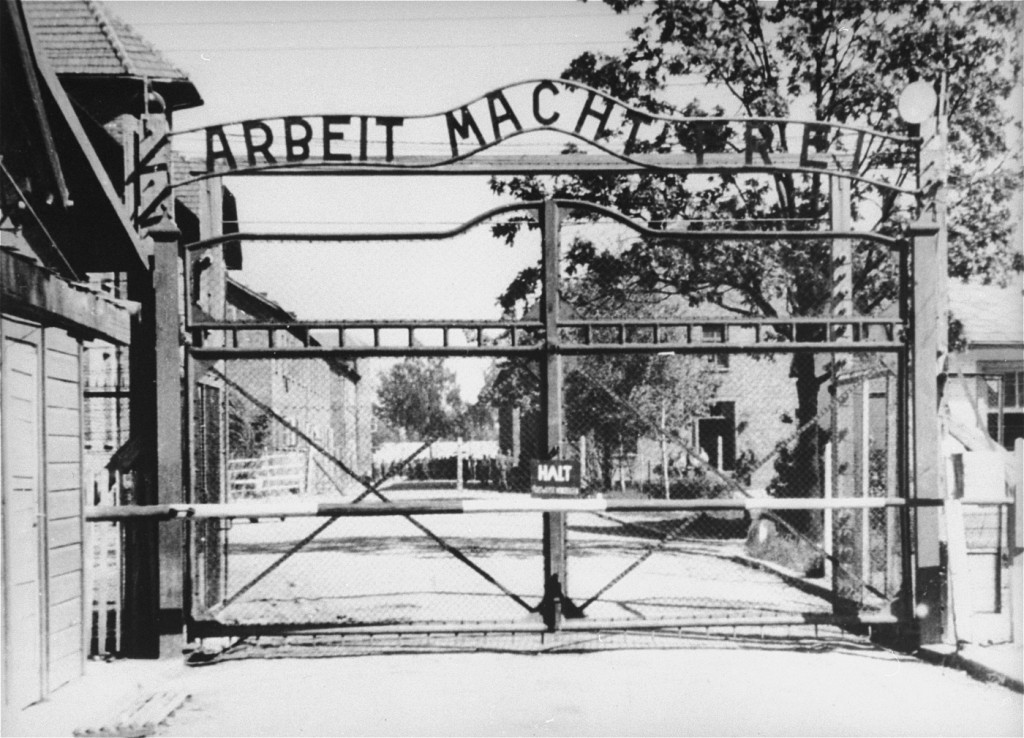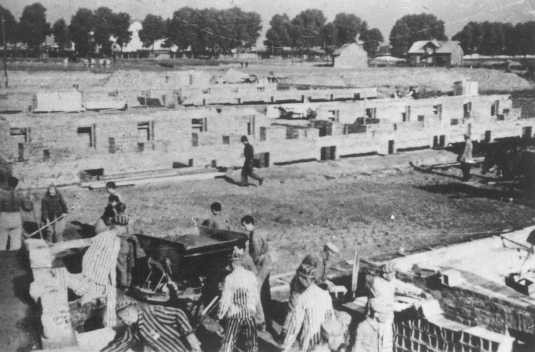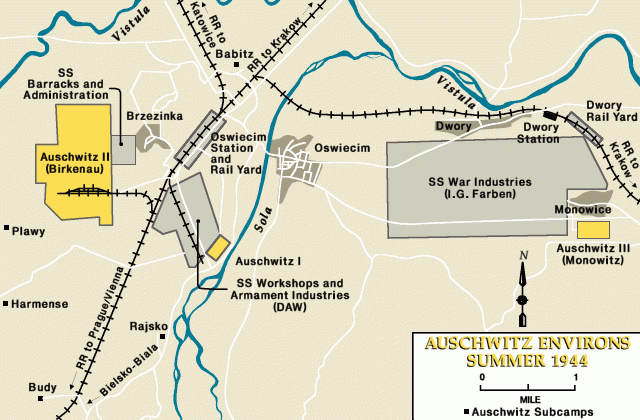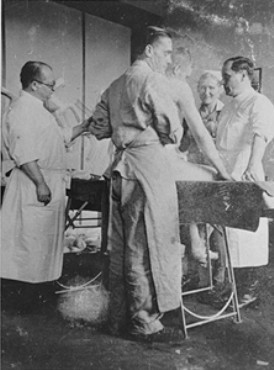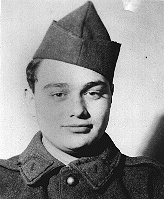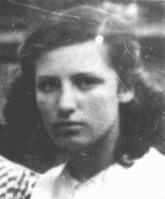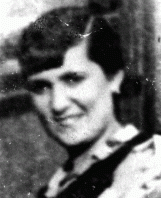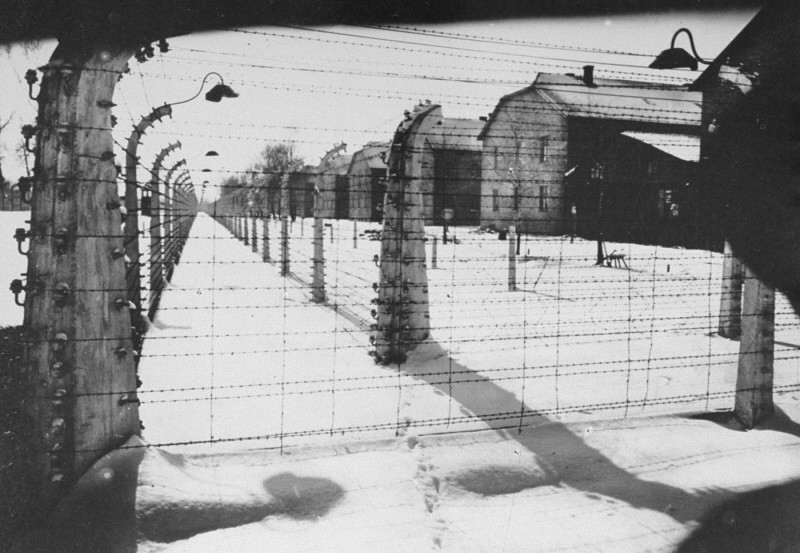
Auschwitz Camp Complex
Auschwitz was the largest camp established by the Germans. It was a complex of camps, including a concentration, extermination, and forced-labor camp. It was located near Cracow (Krakow), Poland. Three large camps constituted the Auschwitz camp complex: Auschwitz I, Auschwitz II (Birkenau), and Auschwitz III (Monowitz). More than one million people lost their lives at Auschwitz, nine out of ten of them Jewish. The four largest gas chambers could each hold 2,000 people at one time.
A sign over the entrance to the camp read Arbeit macht frei, which means "work makes one free." In actuality, the opposite was true. Labor became another form of genocide that the Nazis called "extermination through work."
Victims who were spared immediate death by being selected for labor were systematically stripped of their individual identities. They had their hair shaved off and a registration number tattooed on their left forearm. Men were forced to wear ragged, striped pants and jackets, and women wore work dresses. Both were issued ill-fitting work shoes, sometimes clogs. They had no change of clothing and slept in the same clothes they worked in.
Each day was a struggle for survival under unbearable conditions. Prisoners were housed in primitive barracks that had no windows and were not insulated from the heat or cold. There was no bathroom, only a bucket. Each barrack held about 36 wooden bunkbeds, and inmates were squeezed in five or six across on the wooden plank. As many as 500 inmates lodged in a single barrack.
Inmates were always hungry. Food consisted of watery soup made with rotten vegetables and meat, a few ounces of bread, a bit of margarine, tea, or a bitter drink resembling coffee. Diarrhea was common. People weakened by dehydration and hunger fell easy victim to the contagious diseases that spread through the camp.
Some inmates worked as forced laborers inside the camp, in the kitchen or as barbers, for example. Women often sorted the piles of shoes, clothes, and other prisoner belongings, which would be shipped back to Germany for use there. The storage warehouses at Auschwitz-Birkenau, located near two of the crematoria, were called "Canada," because the Poles regarded that country as a place of great riches. At Auschwitz, as at hundreds of other camps in the Reich and occupied Europe where the Germans used forced laborers, prisoners were also employed outside the camps, in coal mines and rock quarries, and on construction projects, digging tunnels and canals. Under armed guard, they shoveled snow off roads and cleared rubble from roads and towns hit during air raids. A large number of forced laborers eventually were used in factories that produced weapons and other goods that supported the German war effort. Many private companies, such as I. G. Farben and Bavarian Motor Works (BMW), which produced automobile and airplane engines, eagerly sought the use of prisoners as a source of cheap labor.
Escape from Auschwitz was almost impossible. Electrically charged barbed-wire fences surrounded both the concentration camp and the killing center. Guards, equipped with machine guns and automatic rifles, stood in the many watchtowers. The lives of the prisoners were completely controlled by their guards, who on a whim could inflict cruel punishment on them. Prisoners were also mistreated by fellow inmates who were chosen to supervise the others in return for special favors by the guards.
Cruel "medical experiments" were conducted at Auschwitz. Men, women, and children were used as subjects. SS physician Dr. Josef Mengele carried out painful and traumatic experiments on dwarfs and twins, including young children. The aim of some experiments was to find better medical treatments for German soldiers and airmen. Other experiments were aimed at improving methods of sterilizing people the Nazis considered inferior. Many people died during the experiments. Others were killed after the "research" was completed and their organs removed for further study.
Most prisoners at Auschwitz survived only a few weeks or months. Those who were too ill or too weak to work were condemned to death in the gas chambers. Some committed suicide by throwing themselves against the electric wires. Others resembled walking corpses, broken in body and spirit. Yet other inmates were determined to stay alive.
Key Dates
May 20, 1940
Auschwitz I camp opens
Auschwitz I, the main camp in the Auschwitz camp complex, is the first camp established near Oswiecim. Construction began in May 1940 in the Zasole suburb of Oswiecim, in artillery barracks formerly used by the Polish army. The camp is continuously expanded through the use of forced labor. Although Auschwitz I is primarily a concentration camp, serving a penal function, it also has a gas chamber and crematorium. An improvised gas chamber is located in the basement of the prison (Block 11). Later, a gas chamber is constructed in the crematorium.
October 8, 1941
Construction of Auschwitz II (Birkenau) begins
Construction of Auschwitz II, or Auschwitz-Birkenau, begins in Brzezinka. Of the three camps established near Oswiecim as part of the Auschwitz camp complex, Auschwitz-Birkenau has the largest prisoner population. It is divided into nine sections separated by electrified barbed-wire fences and patrolled by SS guards and dogs. The camp includes sections for women, men, Roma (Gypsies), and families deported from the Theresienstadt ghetto. Auschwitz-Birkenau plays a central role in the German plan to exterminate the Jews of Europe. Four large crematoria buildings are constructed between March and June 1943. Each has three components: a disrobing area, a large gas chamber, and crematorium ovens. Gassing operations continue until November 1944.
October 1942
Auschwitz III camp opens
The Germans establish Auschwitz III, also called Buna or Monowitz, in Monowice to provide forced laborers for the Buna synthetic rubber works (part of the German conglomerate I.G. Farben). I.G. Farben invested more than 700 million Reichsmarks (about 1.4 million US dollars in 1942) in Auschwitz III. Prisoners selected for forced labor are registered and tattooed with identification numbers on their left arms in Auschwitz I. They are then assigned to forced labor in Auschwitz or in one of the many subcamps attached to Auschwitz III.
January 27, 1945
Soviet army liberates Auschwitz camp complex
The Soviet army enters Auschwitz and liberates the remaining prisoners. Only a few thousand prisoners remain in the camp. Almost 60,000 prisoners, mostly Jews, were forced on a death march from the camp shortly before its liberation. During the forced evacuation of Auschwitz, prisoners were brutally mistreated and many were killed. SS guards shot anyone who fell behind. During its brief existence, nearly 1 million Jews were killed in Auschwitz. Other victims included between 70,000 and 74,000 Poles, 21,000 Roma (Gypsies), and about 15,000 Soviet prisoners of war.
Critical Thinking Questions
- Where were the camps located? How might the German population and the local community in Poland have been aware of this camp, its purpose, and the conditions within?
- Did the outside world have any knowledge about these camps? If so, what actions were taken by other countries and their officials? What choices do other countries have in the face of mistreatment of civilians?
- How does the example of this camp demonstrate the complexity and the systematic nature of the German efforts to abuse and kill the Jews?


